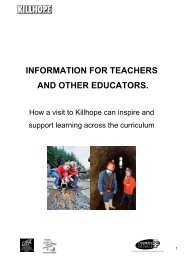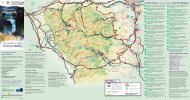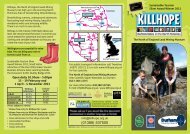Revealing Rocks & Soils - Killhope
Revealing Rocks & Soils - Killhope
Revealing Rocks & Soils - Killhope
Create successful ePaper yourself
Turn your PDF publications into a flip-book with our unique Google optimized e-Paper software.
Creative Science at <strong>Killhope</strong><br />
Inspiring learning through Creative Science<br />
The concept of creative science is an exciting new approach to engaging pupils in<br />
learning about science supported by QCA. Creativity allows for greater flexibility in terms<br />
of learning opportunities. Thinking creatively means that science can be inspiring. Once<br />
the traditional boundaries between arts and science are broken the creative arts can<br />
also be a rich source of inspiration for science learning.<br />
Other boundaries are crossed too. Links can be made to real life situations beyond the<br />
home/ school environment. Undertaking interesting, new scientific experiments relevant<br />
to a particular place and industrial practices enables pupils to gain a better<br />
understanding of scientific principles, their application and usefulness.<br />
Science Detectives<br />
Detectives need to be equipped with a range of special qualities and some special<br />
equipment. Discuss with the class what these special qualities are and what equipment<br />
would be helpful in looking at different rocks and soils in detail.<br />
When the class arrives at <strong>Killhope</strong> Museum, it will be divided into several groups to go<br />
on a tour of the site and look at how rocks and soils are used. When the class gets back<br />
to school one of the tasks will be for each group to report back to others in the class on<br />
their observations, the evidence they have found, the tests and experiments they have<br />
carried out and their experiences.<br />
It is up to individual teachers how far they pursue the ‘science detective’ idea in the<br />
classroom. On site at <strong>Killhope</strong> for the <strong>Rocks</strong> & <strong>Soils</strong> visit the class will be encouraged to<br />
be ‘<strong>Killhope</strong> Science Detectives’. It would be helpful, therefore, if each child could bring a<br />
small magnifying glass on the visit to <strong>Killhope</strong>. Digital cameras, video camera and tape<br />
recorders would also be useful.<br />
Pupils will need to understand the importance of<br />
• Close observation and examination of clues<br />
• Gathering and sifting through evidence, then sorting it into different<br />
categories<br />
• Carrying out investigations and tests<br />
• Using different methods to solve a problem<br />
Subject links and cross-curricular learning<br />
Across all four <strong>Killhope</strong> Creative Science Teachers Resource Packs art, drama and<br />
dance are used when appropriate as innovative approaches to experiential learning in<br />
primary science alongside ‘hands-on’, interactive practical sessions at the Museum.<br />
Cross-curricular learning is encouraged, in particular the use of ICT and literacy.<br />
In turn pupils of primary school age are inspired to explore experiment and gain an<br />
understanding of the need to understand and apply scientific principles in a ‘real life’<br />
situation – lead mining at <strong>Killhope</strong> in the nineteenth century.<br />
6







